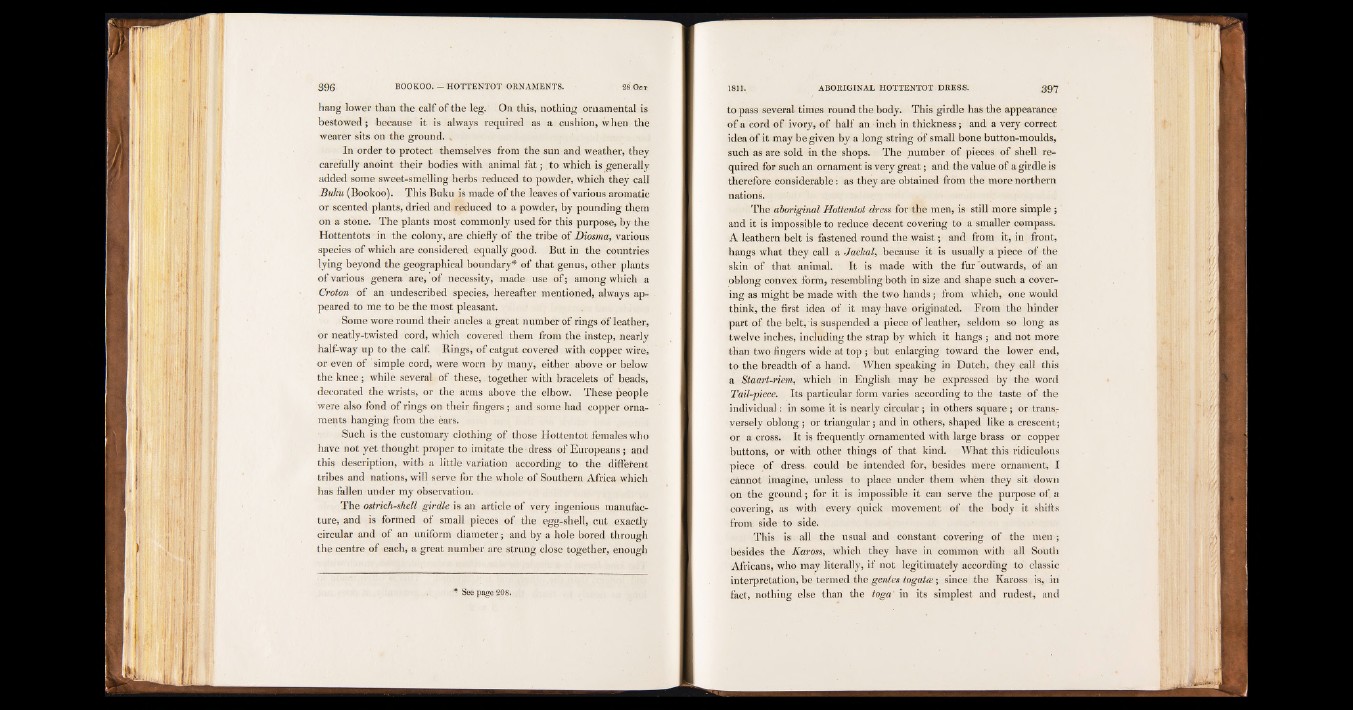
hang lower than the calf of the leg. On this, nothing ornamental is
bestowed; because it is always required as a cushion, when the
wearer sits on the ground. „
In order to protect themselves from the sun and weather, they
carefully anoint their bodies with animal fa t; to which is generally
added some sweet-smelling herbs reduced to powder, which they call
Bnku (Bookoo). This Buku is made of the leaves of various aromatic
or scented plants, dried and reduced to a powder, by pounding them
on a stone. The plants most commonly used for this purpose, by the
Hottentots in the colony, are chiefly of the tribe of Diosma, various
species of which are considered equally good. But in the countries
lying beyond the geographical boundary* of that genus, other plants
of various genera are, of necessity, made use of; among which a
Croton of an undescribed species, hereafter mentioned, always appeared
to me to be the most pleasant.
Some wore round their ancles a great number of rings of leather,
or neatly-twisted cord, which covered them from the instep, nearly
half-way up to the calf. Rings, of catgut covered with copper wire,
or even of simple cord, were worn by many, either above or below
the knee; while several of these, together with bracelets of beads,
decorated the wrists, or the arms above the elbow. These people
were also fond of rings on their fingers; and some had copper ornaments
hanging from the ears.
Such is the customary clothing of those Hottentot females who
have not yet thought proper to imitate the dress of Europeans; and
this description, with a little variation according to the different
tribes and nations, will serve for the whole of Southern Africa which
has fallen under my observation.
The ostrich-shell girdle is an article of very ingenious manufacture,
and is formed of small pieces of the egg-shell, cut exactly
circular and of an uniform diameter; and by a hole bored through
the centre of each, a great number are strung close together, enough
to pass several times round the body. This girdle has the appearance
of a cord of ivory, of half an inch in thickness; and a very correct
idea of it may be given by a long string of small bone button-moulds,
such as are sold in the shops. The number of pieces of shell required
for such an ornament is very great; and the value of a girdle is
therefore considerable: as they are obtained from the more northern
nations.
The aboriginal Hottentot dress for the men, is still more simple ;
and it is impossible to reduce decent covering to a smaller compass.
A leathern belt is fastened round the waist; and from it, in front,
hangs what they call a Jackal, because it is usually a piece of the
skin of that animal. It is made with the fur‘outwards, of an
oblong convex form, resembling both in size and shape such a covering
as might be made with the two hands ; from which, one would
think, the first idea of it may have originated. From the hinder
part of the belt, is suspended a piece of leather, seldom so long as
twelve inches, including the strap by which it hangs ; and not more
than two fingers wide at top ; but enlarging toward the lower end,
to the breadth of a hand. When speaking in Dutch, they call this
a Staart-riem, which in English may be expressed by the word
Tail-piece. Its particular form varies according to the taste of the
individual: in some it is nearly circular ; in others square; or transr
versely oblong; or triangular; and in others, shaped like a crescent;
or a cross. It is frequently ornamented with large brass or copper
buttons, or with other things of that kind. What this ridiculous
piece of dress, could be intended for, besides mere ornament, I
cannot imagine, unless to place under them when they sit down
on the ground; for it is impossible it can serve the purpose of. a
covering, as with every quick movement of the body it shifts
from side to side.
This is all the usual and constant covering of the men;
besides the Kaross, which they have in common with all South
Africans, who may literally, if not legitimately according to classic
interpretation, be termed the gentes togatce; since the Kaross is, in
fact, nothing else than the toga in its simplest and rudest, and